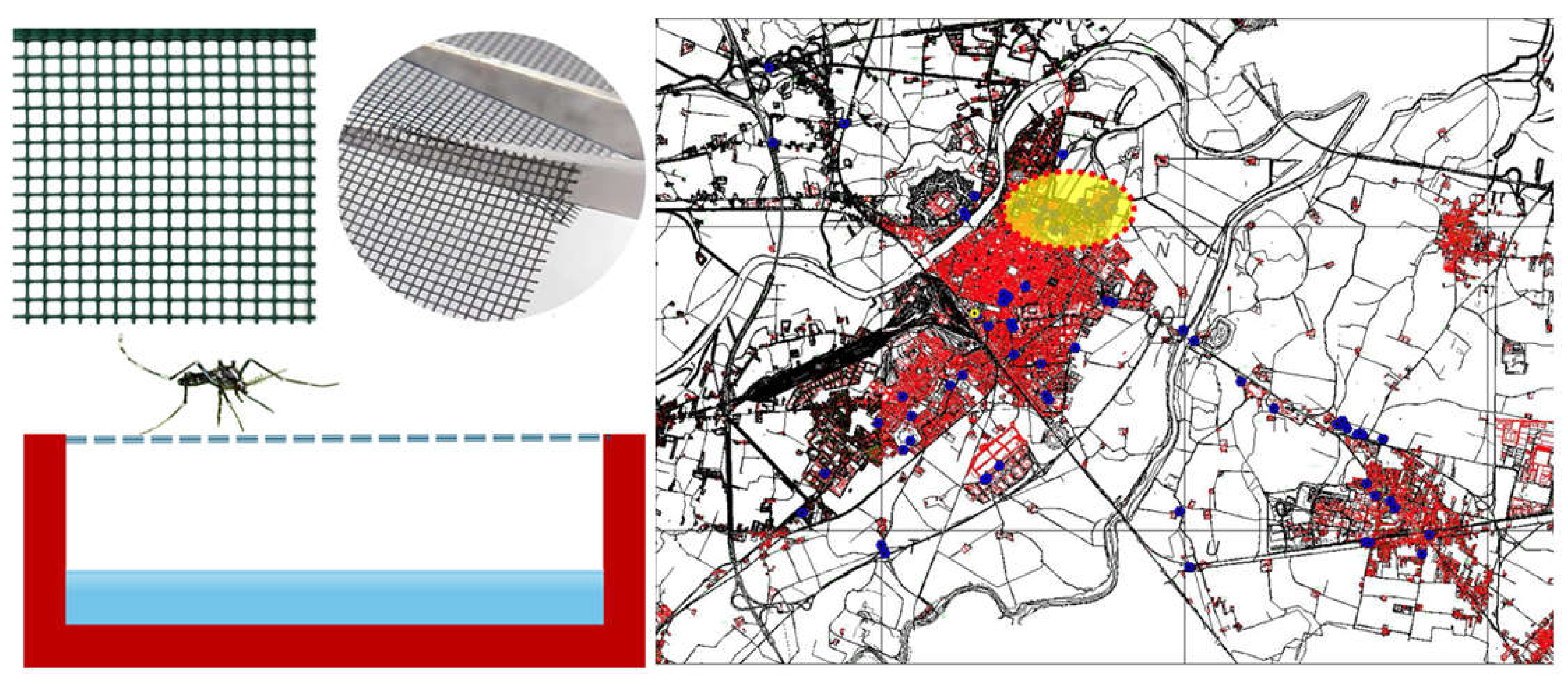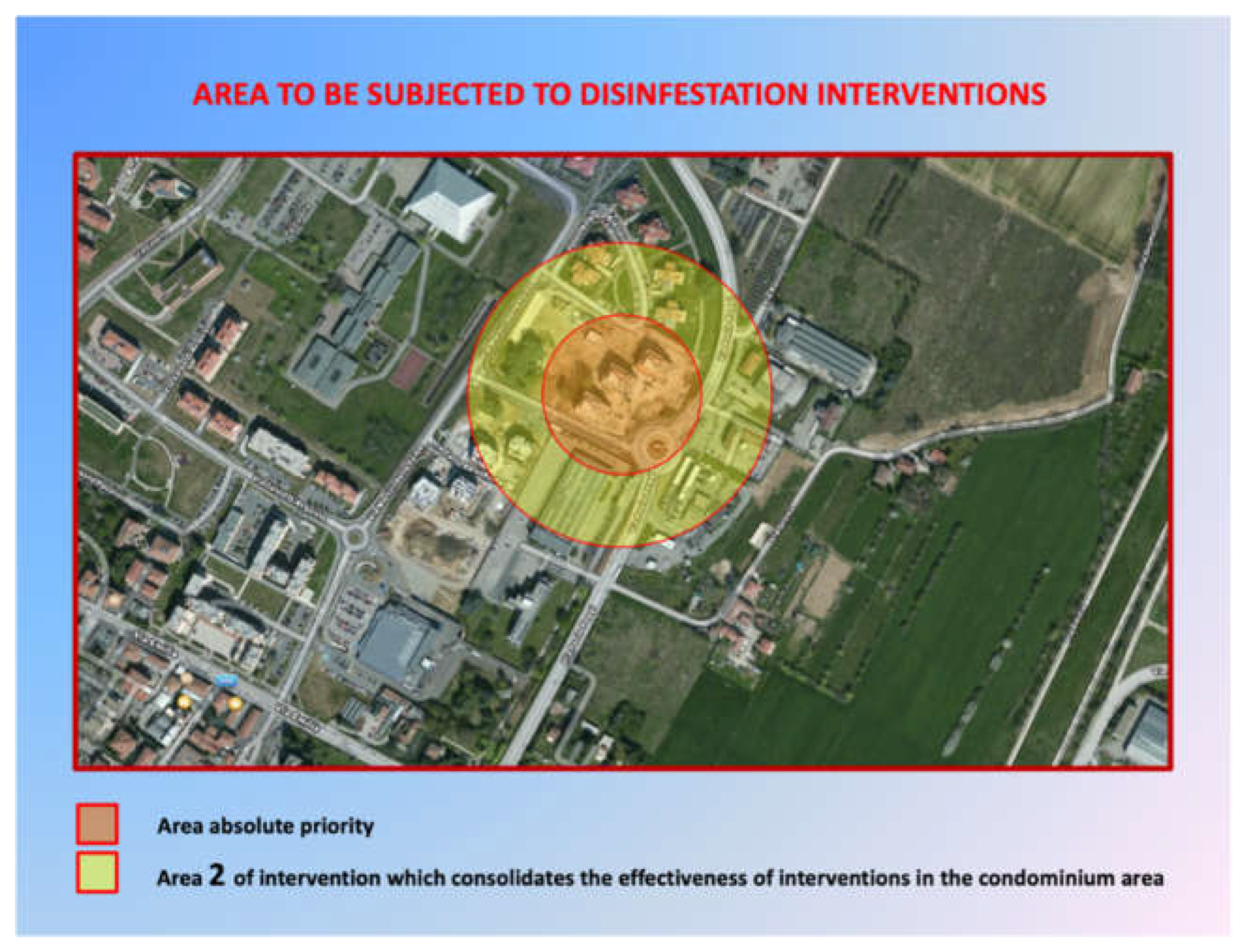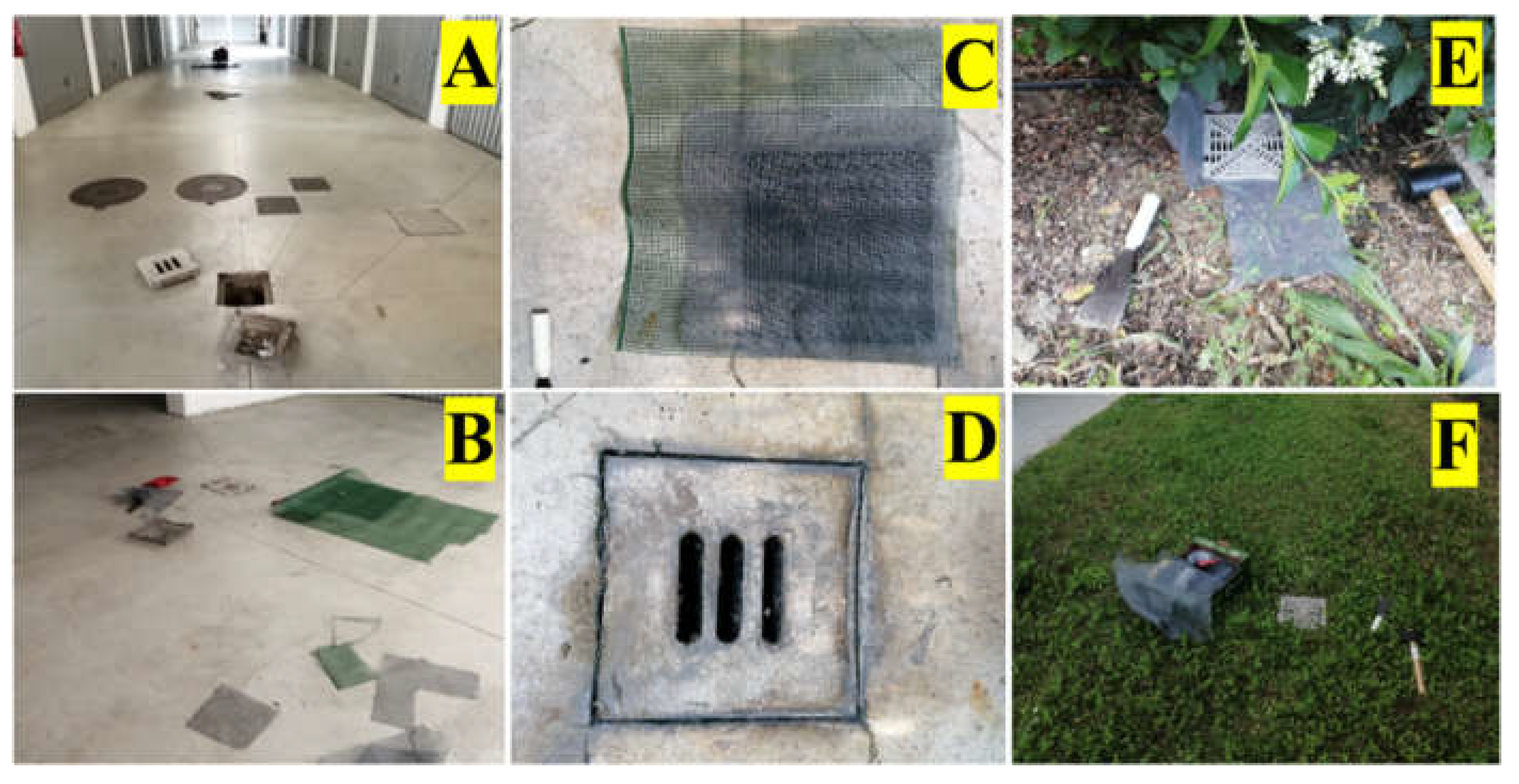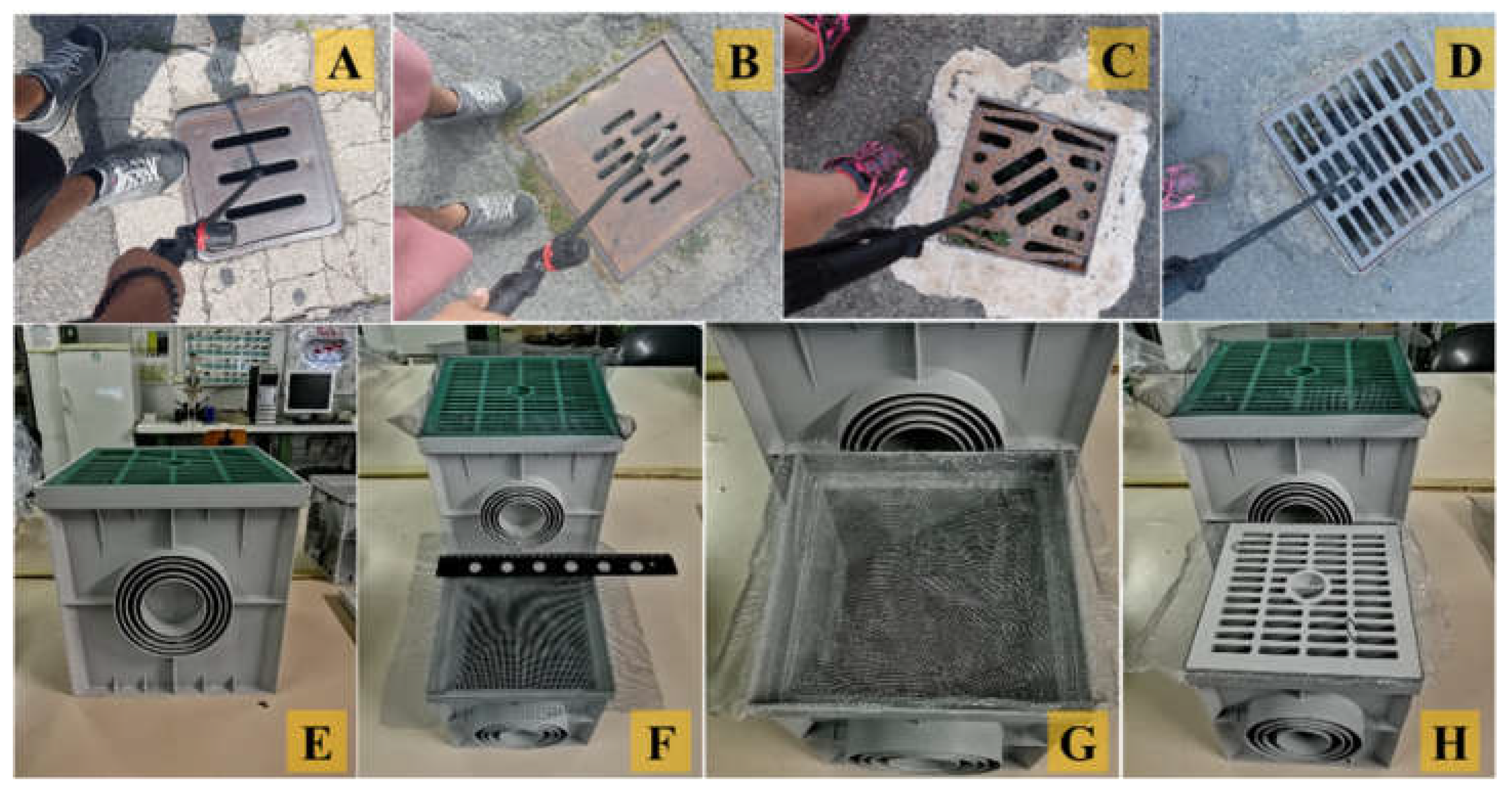Preprint
Article
An Innovative Method to Deal with the Spread of Aedes albopictus in the Urban Centers of Alessandria Used by Citizen
Altmetrics
Downloads
93
Views
43
Comments
0
This version is not peer-reviewed
Submitted:
02 July 2024
Posted:
03 July 2024
You are already at the latest version
Alerts
Abstract
Introduction: Known for its persistent blood-feeding behavior from dawn to dusk, Aedes albopictus is recognized as one of the most dangerous mosquito species due to its role as a vector for diseases such as dengue. Studies have demonstrated that Aedes albopictus thrives in micro-breeding sites predominantly located on private properties, including abandoned containers and manholes used for rainwater and irrigation. This study investigates an innovative methodology, the TombiniNet, to mitigate the proliferation of Aedes albopictus by engaging citizens in the active management of micro-breeding sites on their properties. Materials and Methods: The study was conducted in Alessandria, a city with approximately 100,000 inhabitants, focusing on a sample of 200 houses and a population of about 5,000 people. Researchers conducted a comprehensive survey and analysis of micro-breeding sites for Aedes albopictus on both private and communal properties. The larval control measures were conducted from April to October, aligning with the peak mosquito breeding season. The study's sample included 51% of houses that allowed researchers access, and within these, 81% had Aedes albopictus larvae, often found in diverse water Containers holes of which basically manholes on villa garden floors. For monitoring the adult populations were used ovitraps that were not placed in private homes but in public areas to monitor and control the mosquito population. Results: The study identified that up to 70% of micro-breeding sites for Aedes albopictus in northern Alessandria were located on private properties. Citizen participation was critical to the success of the intervention, with a marked decrease in the number of adult tiger mosquitoes observed in areas where residents actively managed breeding sites using the TombiniNet. The TombiniNet was particularly effective in private areas, as it could be regularly maintained by residents, preventing debris accumulation that could hinder drainage. Discussion: The findings highlight the importance of engaging citizens in mosquito control programs to effectively manage Aedes albopictus populations in urban areas. The TombiniNet intervention demonstrated that a simple, cost-effective solution could significantly reduce mosquito breeding sites on private properties. By addressing both communal and private breeding sites, a comprehensive and sustainable approach to mosquito management can be achieved, thereby reducing the risk of disease transmission. Future studies should focus on long-term monitoring and the development of additional innovative solutions to enhance citizen participation and control measures. The study's success also pointed out the limitations of applying such interventions in public areas where debris could impede the net's effectiveness.

Keywords:
Subject: Biology and Life Sciences - Insect Science
1. Introduction
Aedes albopictus, commonly known as the tiger mosquito, is a highly aggressive species known for its persistent blood-feeding behavior from dawn to dusk. This species has a broad geographical range, extending from Southeast Asia to the United States, Northern Europe, and Africa. Ae. albopictus is notorious not only for its aggressive behavior but also for its role as a significant vector for several serious diseases, including dengue recently come to the fore for local transmission in Southern Europe a particularly in Italy and France [1,2,3,4].
In urban environments, particularly in the city of Alessandria, Italy, Ae. albopictus has become a major public health concern. The dense population and urban layout provide numerous breeding sites for these mosquitoes, exacerbating their proliferation. Studies have shown that Ae. albopictus thrives in micro-breeding sites that are often found on private properties. These sites include abandoned containers, manholes used for rainwater and irrigation, and other small water containers and retaining structures[3,5,6]. Effective larval control measures have been implemented in communal areas to some extent. However, interventions on private properties remain insufficient due to the difficulties in managing these scattered and often neglected breeding sites. This gap in effective mosquito control has led to the continuous spread and reproduction of Ae. albopictus, posing a persistent threat to public health[7,8].
To address this issue, this study introduces an innovative methodology named the TombiniNet. The TombiniNet is a do-it-yourself (DIY) mosquito netting solution designed to cover manholes and drains, thereby preventing mosquito access to these breeding sites. This study aims to investigate the effectiveness of the TombiniNet in mitigating the proliferation of Ae. albopictus by actively engaging citizens in the management of micro-breeding sites on their properties[8,9]. By focusing on both private and communal properties, the study aims to provide a comprehensive approach to mosquito control in Alessandria. The involvement of citizens is a crucial component, as it ensures the sustainability and effectiveness of the intervention. This study's findings are expected to contribute significantly to the development of practical, cost-effective solutions for urban mosquito control and to reduce the transmission of mosquito-borne diseases in Alessandria and similar urban centers.
2. Materials and Methods
The study was conducted in Alessandria, a city located in the Piedmont region of Italy, with a population of approximately 100,000 inhabitants. Specifically, the study focused on a sample of 200 houses within the city, covering a population of about 5,000 people (Figure 1). This sample provided a representative view of the urban mosquito breeding sites and the effectiveness of control measures in both private and communal areas. Researchers conducted a comprehensive survey to identify and analyze micro-breeding sites for Ae. albopictus. These sites included a variety of water-retaining structures such as manholes, watering cans, containers, and other small areas where water could accumulate. The survey aimed to determine the prevalence and distribution of mosquito larvae across these habitats[10,11,12].
Key findings from Door-to-Door survey indicated that 51% of the houses allowed access to researchers. In 81% of these accessible houses, Ae. albopictus larvae were found, often in water holes on the floors of villa gardens. In general, 70% of larval gnats were located in houses, while 30% were found on the street. The primary intervention strategy involved the use of “TombiniNet”, a DIY mosquito netting solution designed to cover manholes and drains, preventing mosquito access (Figure 1).
This innovative method aimed to block mosquitoes from utilizing these sites for breeding, thereby reducing the overall mosquito population and avoiding the exit of mosquitoes generated by any pre-imaginal forms of mosquitoes already present at the time of installation. The materials used for TombiniNet included, Anti -flame Plastics netting, Aluminium netting and in some cases associated with a large mesh net layer to better hold upper small mesh size smaller than mosquito size net Chosen for its durability and resistance to environmental stressors such as burning from cigarette butts. Unlike plastic nets, aluminium nets could fold without sustaining damage. The TombiniNet was specifically applied in private areas where it could be regularly maintained and cleaned by residents. This regular maintenance was crucial to prevent debris accumulation, which could otherwise obstruct the nets and reduce water flow.
The TombiniNet intervention was implemented in a big condominium area in the municipality of San Lazzaro di Savena Bologna province. This area included three residential buildings, each with six floors, totaling 69 flats, of which 12 were ground-level flats with large private gardens (see towers area in pictures below). This setting provided a diverse range of manholes and water-retaining structures to test the effectiveness of the TombiniNet. The intervention focused on, covering manholes with different materials and shapes, including iron (50×50 cm), concrete (40×40 cm and 50×50 cm), and plastic (20×20 cm) and simultaneously weekly inspection activity and replacement of 150 ovitraps deployed previously across in Alessandria and repeated with minor number according to this limited covering condominium area, though these were not placed in private homes. A satisfaction survey from residential people were investigated, with almost total very positive opinions (better to move to Data collection and analysis chapter) (Table 1).
The effectiveness of the TombiniNet was assessed through, Field observations: Regular inspections to monitor the presence of mosquito larvae and adult mosquitoes. Citizen participation metrics: Engagement of residents in maintaining and cleaning the nets, which was crucial for the intervention’s success. Mosquito population monitoring: Comparing the number of mosquitoes before and after the implementation of the TombiniNet. The intervention period spanned from April to October, which corresponds to the peak mosquito breeding season. This period allowed researchers to capture the full impact of the TombiniNet on the mosquito population.
In addition to the TombiniNet intervention in private areas, biological larvicides and Insect Growth Regulators (IGRs) such as VectoMax and Device were used in communal areas where the TombiniNet was not feasible. This dual approach ensured comprehensive mosquito control across different urban settings. Since its initial implementation in 2013, the TombiniNet intervention has been continuously monitored and adapted based on effectiveness and resident feedback. The study includes data up to 2024, providing a long-term perspective on the intervention’s sustainability and impact.
Zero mosquito has been generated from 50 manholes checked slimly perfect function of TombiniNet presenting in private properties of condominium area of San Lazzaro (see the map with towers) (Figure 2).
Overall, the materials and methods employed in this study aim to provide a replicable model for urban mosquito control that combines innovative technology with active citizen participation.
2.1. Manhole CoversNet (Mosquito Nets on Manholes)
Device designed, proposed and successfully used and Its purpose is to prevent the passage of adult forms of mosquitoes into manholes for oviposition and possibly the emergence of adult species mosquitoes, following the development of any “wriggler” lives in water of mosquitoes (eggs, larvae, pupae) already present in manholes (catch basin) before installing the covers net and Feature and shape: mesh net smaller than 2mm2<meshes>1mm2 of plastic and aluminium (does not get punctured by cigarette butts). Easily found on the market (hardware, hobby shops...) and its cost is small, less than one euro per manhole and its installation is quick and easy.
Instruction: carefully lift the lid of the manhole, clean well the edges of the lid where to fit, extend the net over the manhole, fix fittingly the lid over the net and make sure the net is locked under the lid. Cut out the rest of the net excess left out by scissors. Remove manhole covers at the end of and its benefits prevent the entry and exit of mosquitoes and other insects such as cockroaches and other crawling insects, mice, lizards, grass snakes and No use of chemical or biological products.
To install for the manholes in the private garden and clean the dried leaves or debris possibly clogged in the sump slots and if the manhole is large and there is the possibility that TombiniNet comes off and goes down. Use a plastic net with large mesh >10 mm, such as Square Mesh Plastic or usually used as protective net for balconies, gates and fences, placing it under the manhole cover to hold the manhole cover located above. Once the manhole cover has been removed, first extend this “protective net” onto the manhole and then place the manhole cover on the protective net. Then, carefully put the cover lid on the manhole net and gently make sure that the cover enters its place with two nets, perhaps with the help of a hammer. Make sure that the cover is well inserted then, cut the excess pieces. This mesh screen large by making it thick, it also prevents the lid from moving once inserted.
3. Results
The comprehensive survey conducted in Alessandria revealed critical insights into the distribution and prevalence of Ae. albopictus breeding sites. Key findings include, out of the 200 houses surveyed, 51% (102 houses) allowed researchers to inspect their premises. This level of participation provided a substantial data set for analyzing the prevalence of mosquito breeding sites. Among the houses that participated, 81% (approximately 83 houses) had Ae. albopictus larvae. These larvae were predominantly found in manholes on the floors of villa gardens. The different public awarenesses campaign sorted out positive response from citizen through removing almost all removable water containers except avoiding manholes danger. Overall, 70% of the mosquito larvae were found in private properties (houses), while 30% were located in public areas (streets). This distribution highlighted the significant role of private properties in the proliferation of Ae. albopictus (Figure 3).
The TombiniNet intervention was assessed based on its ability to reduce mosquito breeding sites and the subsequent mosquito population in the study area. Key results include, The TombiniNet was applied to 40 out of 70 manholes in a condominium area. The remaining manholes, located in public areas, were treated with biological larvicides and Insect Growth Regulators (IGRs) and the aluminum net used in the TombiniNet proved to be highly durable. It was resistant to environmental stressors such as burning from cigarette butts, unlike plastic nets. The residents’ regular maintenance and cleaning of the nets ensured their continued effectiveness (Figure 4).
The application of TombiniNet in private areas resulted in a significant reduction in the presence of mosquito larvae. This reduction was attributed to the effective blockage of mosquito access to water-retaining structures. The study monitored the mosquito population through regular inspections and the use of ovitraps. Key findings include, A total of 150 ovitraps were deployed across the city, specifically in public areas. These ovitraps were inspected and replaced 2-weekly, providing consistent data on mosquito population dynamics by counting number of eggs laid on standard (13×3 cm) wooden strips in ovitraps, the involvement of citizens in maintaining the TombiniNet was crucial. Regular cleaning and inspection by residents prevented the accumulation of debris, which could obstruct the nets and reduce their effectiveness, The intervention led to a noticeable decrease in the number of adult Ae. albopictus mosquitoes in areas where the TombiniNet was actively maintained. This trend was consistent throughout the intervention period from April to October.
A total of 82 local cases of dengue reported in Italy mostly in northern Italy is a concern also in Alessandria’s jurisdiction (see map) While direct connection cannot be established solely based on the TombiniNet intervention, the reduction in mosquito breeding sites likely contributing to a lower risk of low population of vector of dengue and its transmission case associated to existence of human reservoir circulating in area. Since its initial implementation in 2013, the TombiniNet intervention has demonstrated long-term sustainability and effectiveness. The continued success of the method up to 2024 underscores its viability as a mosquito control strategy basically used by citizen a homemade device at zero cost rapid and easy to install. The study’s findings suggest that with consistent citizen participation and maintenance, the TombiniNet can provide a durable and effective solution for urban mosquito control.
In public areas, the effectiveness of the TombiniNet was reduced due to the accumulation of debris such as falling leaves and cigarette butts. This necessitated the use of biological larvicides and IGRs as supplementary measures. The varying levels of participation from residents posed a challenge. Only 51% of the houses allowed access for inspection, indicating a need for increased community engagement and awareness. Considering the high number of manholes, that is the main micro breeding sites of Ae. albopictus, and considering that citizens will accept this measure, its implementation will become an irreplaceable measure for mosquito control and consequently lowering the health risks linked to this bloodsucking insect in case it become a VBD vector.
The results of the study indicate that the TombiniNet is a practical and cost-effective solution for controlling Ae. albopictus in urban areas. By engaging citizens in the active management of mosquito breeding sites on private properties, the intervention successfully reduced the mosquito population and the associated risk of disease transmission. The combination of innovative technology and community involvement provides a replicable model for other urban centers facing similar challenges.
4. Discussion
The success of the TombiniNet intervention underscores the critical role of citizen participation in mosquito control programs. By actively involving residents in the management of mosquito breeding sites on their properties, the study demonstrated that community engagement is essential for sustainable and effective mosquito control. The high rate of larval presence (81%) in the houses that allowed access highlights the importance of private properties as key sites for mosquito breeding. Therefore, empowering residents to manage these sites can significantly reduce mosquito populations.
The TombiniNet intervention provided several notable advantages, The use of aluminum nets instead of plastic offered enhanced durability. The aluminum nets were resistant to environmental stressors such as burning from cigarette butts, which is a common issue with plastic nets. This resilience ensured the nets remained functional over extended periods, reducing the need for frequent replacements, The TombiniNet was designed to be a DIY solution, allowing residents to install and maintain the nets themselves. This ease of use facilitated regular cleaning and inspection, preventing debris accumulation that could impede the nets' effectiveness. The involvement of residents in maintenance ensured that the nets were kept in optimal condition, thereby maximizing their impact and Implementing the TombiniNet was a cost-effective strategy compared to other mosquito control methods. By leveraging citizen participation, the initiative reduced the need for extensive government intervention and the associated costs. This approach is particularly valuable in resource-limited settings where funding for large-scale mosquito control programs may be constrained.
Despite its success, the study also identified several challenges and limitations, in public areas, the effectiveness of the TombiniNet was diminished due to the accumulation of debris such as falling leaves and cigarette butts. This issue necessitated the use of supplementary measures like biological larvicides and Insect Growth Regulators (IGRs) to maintain control over mosquito populations in these areas, The varying levels of participation among residents posed a challenge. While 51% of the houses allowed access for inspection, there was still a significant portion of the population that did not participate. Increasing community engagement and awareness is crucial to achieving broader coverage and more comprehensive mosquito control and the intervention was most effective during the peak mosquito breeding season from April to October. Continuous monitoring and maintenance are required to ensure the intervention remains effective throughout the year, particularly during off-peak seasons when mosquito activity may still pose a risk.
The study recorded approximately 82 endemic dengue cases in Alessandria in 2023. While the direct impact of the TombiniNet on reducing dengue transmission cannot be conclusively determined from this study alone, the reduction in mosquito breeding sites likely contributed to a lower risk of dengue outbreaks. By minimizing the population of Ae. albopictus, the primary vector for dengue, the intervention has the potential to reduce the incidence of dengue and other mosquito-borne diseases[12,13]. The long-term sustainability of the TombiniNet intervention is a significant finding of this study. Since its initial implementation in 2013, the method has continued to be effective up to 2024, demonstrating its viability as a long-term solution for urban mosquito control. The sustained success of the intervention indicates that with ongoing community involvement and proper maintenance, the TombiniNet can provide a durable and effective means of controlling Ae. albopictus populations[12].
Future studies should focus on expanding the TombiniNet intervention to a broader range of urban settings and exploring additional innovative solutions to enhance its effectiveness. Specifically, research should investigate, developing strategies to address the challenges of debris accumulation in public areas. This could include designing improved netting solutions that are less prone to obstruction or implementing regular cleaning protocols for public installations, implementing targeted educational campaigns to raise awareness about the importance of mosquito control and encourage greater participation from residents. Engaging community leaders and local organizations could also help to foster a sense of collective responsibility and ownership and establishing robust monitoring and evaluation frameworks to assess the long-term impact of the TombiniNet intervention on mosquito populations and disease transmission. This should include regular data collection and analysis to identify trends and inform adaptive management strategies.
The TombiniNet initiative in Alessandria provides a compelling example of how innovative, community-based solutions can effectively address urban mosquito control challenges. By combining durable materials, DIY installation, and active citizen participation, the intervention successfully reduced mosquito breeding sites and the associated public health risks. The study's findings highlight the importance of integrating community engagement into mosquito control programs and suggest that similar approaches could be replicated in other urban centers facing mosquito-borne disease threats.
Funding
This study received no grants from commercial, public, or nonprofit entities.
Competing interests
The authors declare that they have no competing interests.
Availability of data and materials
All data obtained from this research are included in the article main text.
Contributions of the Authors
E.A. and A.T. collected mosquitoes and identified mosquito species, recorded geographic coordinates and local information, E.A. and A.T. wrote the article and approved and submitted the articles.
Ethical Approval and Consent to Participate
Not applicable.
Consent to Participate
Not applicable.
Consent to Publication
The authors fully consent to the publication of the article.
Acknowledgments
The authors thank the Italian Mosquito Control Association.
References
- Deblauwe, I.; Sohier, C.; Schaffner, F.; Rakotoarivony, L.M.; Coosemans, M. Implementation of surveillance of invasive mosquitoes in Belgium according to the ECDC guidelines. Parasites Vectors 2014, 7, 201–201. [Google Scholar] [CrossRef] [PubMed]
- Baral, S.; Gautam, I.; Singh, A.; Chaudhary, R.; Shrestha, P.; Tuladhar, R. Microbiota Diversity Associated with Midgut and Salivary Gland of Aedes aegypti and Aedes albopictus. Tribhuvan Univ. J. Microbiol. 2023, 105–115. [Google Scholar] [CrossRef]
- Adeleke, E.D.; Shittu, R.A.; Beierkuhnlein, C.; Thomas, S.M. High Wind Speed Prevents the Establishment of the Disease Vector Mosquito Aedes albopictus in Its Climatic Niche in Europe. Front. Environ. Sci. 2022, 10. [Google Scholar] [CrossRef]
- Metelmann, S.; Liu, X.; Lu, L.; Caminade, C.; Liu, K.; Cao, L.; Medlock, J.M.; Baylis, M.; Morse, A.P.; Liu, Q. Assessing the suitability for Aedes albopictus and dengue transmission risk in China with a delay differential equation model. PLOS Neglected Trop. Dis. 2021, 15, e0009153. [Google Scholar] [CrossRef] [PubMed]
- Abbasi, E.; Vahedi, M.; Bagheri, M.; Gholizadeh, S.; Alipour, H.; Moemenbellah-Fard, M.D. Monitoring of synthetic insecticides resistance and mechanisms among malaria vector mosquitoes in Iran: A systematic review. Heliyon 2022, 8, e08830. [Google Scholar] [CrossRef] [PubMed]
- Chouin-Carneiro T, dos Santos FB. Transmission of major arboviruses in Brazil: the role of Aedes aegypti and Aedes albopictus vectors. Biological Control of Pest and Vector Insects. 2017;2.
- Abbasi, E.; Rafinejad, J.; Hosseinpoor, S.; Gholami-Borujeni, F.; Gholizadeh, S. Diversity of Arthropods in Municipal Solid Waste Landfill of Urmia, Iran. J. Med Èntomol. 2018, 56, 268–270. [Google Scholar] [CrossRef] [PubMed]
- Demers, J.; Bewick, S.; Agusto, F.; Caillouët, K.A.; Fagan, W.F.; Robertson, S.L. Managing disease outbreaks: The importance of vector mobility and spatially heterogeneous control. PLOS Comput. Biol. 2020, 16, e1008136. [Google Scholar] [CrossRef] [PubMed]
- Ghahvechi Khaligh F, Djadid ND, Farmani M, Asadi Saatlou Z, Frooziyan S, Abedi Astaneh F, et al. Molecular monitoring of knockdown resistance in head louse (Phthiraptera: Pediculidae) populations in Iran. Journal of medical entomology. 2021;58(6):2321-9.
- Shaikevich, E.; Talbalaghi, A. Molecular Characterization of the Asian Tiger Mosquito Aedes albopictus (Skuse) (Diptera: Culicidae) in Northern Italy. ISRN Èntomol. 2013, 2013, 1–6. [Google Scholar] [CrossRef]
- Stefopoulou, A.; Balatsos, G.; Petraki, A.; LaDeau, S.L.; Papachristos, D.; Michaelakis, A. Reducing Aedes albopictus breeding sites through education: A study in urban area. PLoS ONE 2018, 13, e0202451. [Google Scholar] [CrossRef] [PubMed]
- Talbalaghi A, Parisato S, Storgato M, Rossi A, fossati F, Bazzoni M, et al. Run Catch® A Novel, Early Warning Adult Mosquito Trap for Rapid, Low Cost, Extensive Entomological Surveillance and Risk Assessment of Mosquito-Borne Viruses and Malaria ACTA SCIENTIFIC MEDICAL SCIENCES. 2020.
- Talbalaghi A, Moutailler S, Vazeille M, Failloux AB. Are Aedes albopictus or other mosquito species from northern Italy competent to sustain new arboviral outbreaks? Medical and Veterinary Entomology. 2010;24(1):83-7.
Figure 1.
Map of ovitraps in city of Alessandria and yellow area where the survey of Ae. albopictus in houses were caried out 200 houses during door-to-door campaign. the scheme of a manhole and TombiniNet that prevents access to the tiger mosquito due to oviposition.
Figure 1.
Map of ovitraps in city of Alessandria and yellow area where the survey of Ae. albopictus in houses were caried out 200 houses during door-to-door campaign. the scheme of a manhole and TombiniNet that prevents access to the tiger mosquito due to oviposition.

Figure 2.
The map with towers.

Figure 3.
manholes on the floors of villa gardens.

Figure 4.
The TombiniNet intervention.

Table 1.
The cover of manholes is of the following feasures.
| Material used | Shape Measure | Number | TombiniNet |
| Iron | 50×50 | 20 | No |
| Concrete | 40×40 50×50 |
20 10 |
Yes No |
| Plastic | 20×20 | 20 | Yes |
Disclaimer/Publisher’s Note: The statements, opinions and data contained in all publications are solely those of the individual author(s) and contributor(s) and not of MDPI and/or the editor(s). MDPI and/or the editor(s) disclaim responsibility for any injury to people or property resulting from any ideas, methods, instructions or products referred to in the content. |
© 2024 by the authors. Licensee MDPI, Basel, Switzerland. This article is an open access article distributed under the terms and conditions of the Creative Commons Attribution (CC BY) license (http://creativecommons.org/licenses/by/4.0/).
Copyright: This open access article is published under a Creative Commons CC BY 4.0 license, which permit the free download, distribution, and reuse, provided that the author and preprint are cited in any reuse.
MDPI Initiatives
Important Links
© 2024 MDPI (Basel, Switzerland) unless otherwise stated







